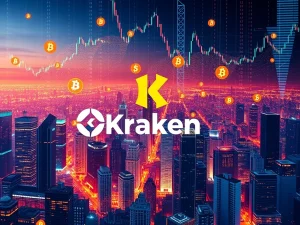FTX Creditor Payouts: Crucial $1.9 Billion Allocation Signals Major Progress

The crypto world has been holding its breath, waiting for a resolution to one of its most infamous sagas: the FTX bankruptcy. After months of legal wrangling and uncertainty, a significant beacon of hope has emerged. The FTX Recovery Trust has announced a crucial step forward, earmarking a staggering $1.9 billion for FTX Creditor Payouts, a move that promises to inject much-needed liquidity back into the hands of those impacted. This pivotal development marks a turning point in the arduous journey toward restitution for thousands of individuals and institutions.
FTX Creditor Payouts: Unpacking the Latest Announcement
The announcement from FTX Trading Ltd. (d/b/a FTX.com) and the FTX Recovery Trust has sent ripples of cautious optimism through the cryptocurrency community. A critical record date of August 15, 2025, has been established for the third round of creditor payouts, with distributions expected to commence on September 30 of the same year. This timeline provides a clear roadmap for claimants eager to recover their assets.
The core of this significant allocation is the release of $1.9 billion in funds to verified claimants. This substantial sum became available following a strategic and much-anticipated $2 billion reduction in the disputed claims reserve. This isn’t just an accounting adjustment; it’s a profound shift in the recovery strategy, prioritizing the expedited return of assets over prolonged legal battles. The process will be meticulously managed by reputable third-party payment processors: BitGo, Kraken, and Payoneer. Their involvement aims to ensure operational efficiency, leveraging their expertise in digital asset management and global payment solutions.
The FTX Trustee has underscored the importance of strict adherence to the August 15 deadline, explicitly stating that no exceptions will be made for late submissions. This firm stance is designed to maintain the integrity and efficiency of the distribution process, ensuring that the recovery moves forward without unnecessary delays. For creditors, this means vigilance and prompt action are paramount.
The Crucial Role of Disputed Claims Reduction
Understanding the ‘disputed claims reserve’ is key to appreciating the magnitude of this development. Historically, such a reserve acts as a contingency fund set aside to cover potential liabilities arising from claims whose validity is still under legal dispute. In complex bankruptcy cases like FTX’s, where claims span a global user base and involve various types of digital assets, these disputes can be numerous and incredibly time-consuming.
The decision to reduce this reserve by $2 billion signals a decisive strategic pivot by the FTX Recovery Trust. Rather than allowing an extensive portion of funds to remain tied up in protracted litigation, these funds are now being redirected to verified creditors. This shift prioritizes resolving claim authenticity through established legal frameworks, thereby accelerating the repayment process. It reflects a pragmatic approach aimed at streamlining the liquidation of FTX’s remaining assets, focusing on concrete outcomes for those with validated claims.
This updated reserve allocation received approval from the U.S. Bankruptcy Court in Delaware in early July, underscoring the rigorous regulatory oversight guiding the distribution process. This court endorsement provides a crucial layer of legitimacy and assurance, signaling that the process is moving forward under strict legal guidance. This move is not just about returning funds; it’s about setting a precedent for how large-scale crypto insolvencies can be managed more efficiently in the future, fostering greater trust in the broader digital asset ecosystem.
Navigating the FTX Bankruptcy Update: Key Dates and Processors
For affected creditors, staying informed about the critical dates and understanding the roles of the appointed payment processors is essential. This FTX Bankruptcy Update brings much-anticipated clarity to the timeline of payouts.
Key Dates for FTX Creditors:
- August 15, 2025: Critical record date for the third round of creditor payouts. This is the cut-off for verifying claims to be included in this distribution.
- September 30, 2025: Expected commencement date for distributions. Creditors should anticipate funds to begin flowing around this time.
The involvement of third-party payment processors – BitGo, Kraken, and Payoneer – introduces a layer of operational efficiency, leveraging their established infrastructure for secure and widespread distributions. BitGo, known for its institutional digital asset custody solutions, and Kraken, a leading cryptocurrency exchange, bring expertise in handling large volumes of crypto transactions. Payoneer, a global payment platform, facilitates cross-border fiat transfers, ensuring that creditors worldwide can receive their funds. While these entities are well-equipped, creditors should be mindful of potential challenges such as cross-border transaction delays, varying regional regulations, or technical challenges during the payout phase. The FTX Trustee has yet to publicly address contingency plans for such scenarios, which leaves some lingering uncertainty over the absolute precision of the timeline. Creditors are strongly advised to monitor official announcements from the FTX Recovery Trust and the appointed payment processors for specific instructions and updates regarding their individual payouts.
What Does This Crypto Creditor Recovery Mean for the Industry?
The allocation of $1.9 billion for Crypto Creditor Recovery is more than just a financial transaction; it carries significant implications for the wider digital asset industry. Firstly, it represents a substantial liquidity injection for thousands of individuals and entities who have had their capital locked up since FTX’s collapse. This influx of funds could potentially be re-invested into the crypto market, contributing to its overall health and activity, or provide much-needed financial relief to those affected.
Secondly, this resolution process could establish a crucial precedent for future cryptocurrency bankruptcies. The strategy of reducing disputed claims to accelerate payouts demonstrates a move towards balancing speed with accuracy, a critical factor in maintaining stakeholder trust in the volatile crypto space. As the industry matures, effective and transparent insolvency procedures become increasingly vital for investor confidence. This approach signals that even in the face of immense complexity, a path to resolution is achievable, offering a blueprint for managing similar large-scale failures.
Moreover, the successful, albeit protracted, navigation of the FTX bankruptcy underscores the growing maturity of legal and regulatory frameworks surrounding digital assets. The involvement and approval of the U.S. Bankruptcy Court in Delaware highlight the increasing integration of traditional legal systems into the nascent crypto ecosystem. This collaboration between blockchain technology and established legal processes is essential for fostering a more stable and regulated environment, ultimately benefiting both institutional and retail participants.
Ensuring Digital Asset Restitution: Challenges and Future Outlook
While the $1.9 billion payout marks a significant stride towards Digital Asset Restitution, the journey is far from over. The complexity of managing claims across a global user base, coupled with the inherent challenges of cross-border transactions and varying jurisdictional restrictions, continues to pose hurdles. Legal battles over claim authenticity have historically slowed distributions, and while the reserve reduction signals a shift, some complexities will inevitably remain.
The FTX Trustee’s ongoing role will be crucial in addressing any unforeseen technical challenges or delays that may arise during the payout phase. The transparency of contingency plans for such scenarios will be vital for maintaining creditor confidence. Despite these potential obstacles, the commitment to prioritizing verified claims is a positive indicator for the future. This approach could serve as a model for how future large-scale crypto insolvencies are handled, emphasizing efficient resolution and asset recovery.
As the September 30 deadline nears, creditors are strongly urged to proactively monitor updates from the FTX Recovery Trust and the appointed payment processors. Ensuring compliance with eligibility requirements and understanding the specific distribution mechanisms will be key to a smooth and timely receipt of funds. This process, while complex, represents a monumental effort to rectify the damages caused by one of crypto’s most infamous collapses, moving closer to a more stable and accountable digital financial landscape.
Conclusion
The allocation of $1.9 billion for FTX Creditor Payouts, driven by a strategic reduction in the disputed claims reserve, is a monumental step forward in the FTX bankruptcy saga. It signals a determined effort by the FTX Recovery Trust to expedite recovery and provide much-needed relief to thousands of affected creditors. While the process remains complex, involving multiple parties and critical deadlines, this development injects a significant dose of optimism into the crypto community. It not only offers a tangible path to restitution for those impacted but also sets a potential precedent for how future large-scale crypto insolvencies might be managed, balancing efficiency with fairness. As the September 30 distribution date approaches, all eyes will be on the successful execution of this crucial phase, marking a new chapter in the ongoing journey towards a more resilient and trustworthy digital asset ecosystem.
Frequently Asked Questions (FAQs)
1. What is the significance of the $1.9 billion allocation for FTX creditors?
The $1.9 billion allocation represents a substantial release of funds to verified FTX claimants, signaling significant progress in the FTX bankruptcy proceedings. It provides much-needed liquidity to thousands of individuals and entities who had their assets locked in the collapsed exchange, moving closer to their long-awaited restitution.
2. What does the reduction in the disputed claims reserve mean for the payout process?
The $2 billion reduction in the disputed claims reserve means that funds previously held back for potential legal disputes are now being redirected to verified creditors. This strategic shift aims to accelerate the payout process by prioritizing the resolution of validated claims over prolonged litigation, streamlining the overall recovery effort.
3. Who are the payment processors involved in the FTX creditor payouts?
The FTX Recovery Trust has appointed three reputable third-party payment processors to manage the distributions: BitGo, Kraken, and Payoneer. Their involvement is intended to ensure efficient and secure handling of both cryptocurrency and fiat transfers to creditors globally.
4. What are the key dates for FTX creditors to remember regarding these payouts?
The critical record date for the third round of creditor payouts is August 15, 2025. Distributions are expected to commence on September 30, 2025. Creditors must ensure their claims are verified and compliant by the August 15 deadline, as no exceptions will be made for late submissions.
5. What challenges might creditors face during the payout process?
While the process is designed for efficiency, creditors might encounter challenges such as cross-border transaction delays, technical issues with payment platforms, or specific regional regulatory hurdles. It is crucial for creditors to monitor official updates from the FTX Recovery Trust and the appointed processors for guidance on navigating these potential obstacles.
6. How does this FTX bankruptcy update impact the broader crypto industry?
This significant FTX bankruptcy update could set a precedent for future large-scale crypto insolvencies, demonstrating a path towards more efficient and transparent recovery processes. It also contributes to restoring trust in the digital asset space by showing that even complex failures can be resolved, potentially encouraging greater regulatory clarity and investor confidence in the long term.







